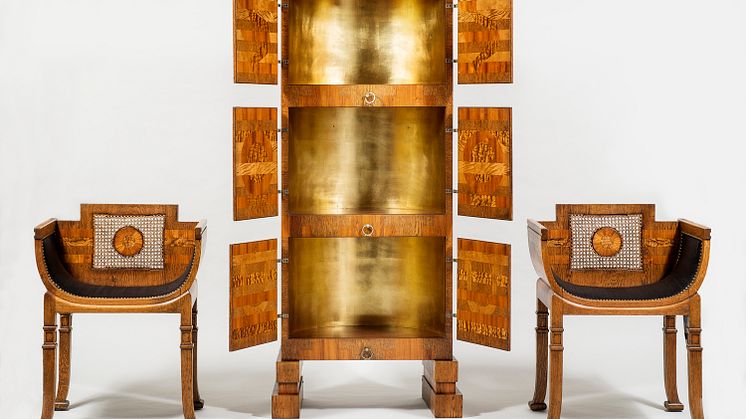
Press release -
New acquisition: Cabinet and armchairs by Carl Hörvik from the 1925 World’s Fair
A cabinet and two chairs designed by Carl Hörvik have been gifted to Nationalmuseum. These exclusive pieces in a pared-down classical style were exhibited in the Swedish pavilion at the 1925 World’s Fair in Paris as part of a suite of furniture that won the exhibition’s highest accolade.
Nationalmuseum is delighted to have received a magnificent gift: a cabinet and two armchairs designed by the architect Carl Hörvik and manufactured by Nordiska Kompaniet for the Swedish pavilion at the 1925 World’s Fair in Paris. The pieces formed part of a larger suite of furniture awarded the exhibition’s highest accolade, the Grand Prix. With their exclusive design, the pieces were definitely produced for the luxury market. The cabinet and the chairs are made of oak, with inlays of various other woods, the chair backs are wicker weave, and the seats are upholstered in horsehair. The cabinet, intended to be displayed with the doors open, contains three gilded niches meant for exhibiting objets d’art.
The 1925 Paris World’s Fair, L’Exposition internationale des arts décoratifs et industriels modernes, proved a great success for Sweden, which won more awards than any country except the host nation. In style terms, the event marked a period of transition. Art Deco, the style named after the exhibition, was at its peak, but the modern functionalist style was also represented, for instance in Le Corbusier’s L’esprit nouveau pavilion.
The Swedish pavilion, designed by Carl Bergsten, and the exhibits in it exemplified a restrained, pared-down classicism, which found favour with contemporary critics. Nationalmuseum already has in its collections the commendation awarded to Carl Hörvik at the World’s Fair and the chandelier by Carl Bergsten that was displayed with the suite of furniture.
The cabinet and chairs have been generously donated by Ernst and Carl Hirsch through the Friends of Nationalmuseum and the Friends of Nationalmuseum.The donation is an important contribution to Nationalmuseum’s efforts to expand its collection of early 20th-century applied art.Nationalmuseum has no budget of its own for new acquisitions, but relies on gifting and financial support from private funds and foundations to enhance its collections of fine art and craft.
Press contacts
Anders Bengtsson, curator, applied art and design
anders.bengtsson@nationalmuseum.se, +46 8 5195 4385
Hanna Tottmar, press officer
hanna.tottmar@nationalmuseum.se, +46 767 234632
Caption
Carl Hörvik, cabinet and armchairs from the 1925 World’s Fair. Photo: Anna Danielsson/Nationalmuseum.
Categories
Nationalmuseum is Sweden’s premier museum of art and design. The collections comprise older paintings, sculpture, drawings and graphic art, and applied art and design up to the present day. The museum building is currently under renovation and scheduled to open again in 2018. In the meantime, the museum will continue its activities through collaborations both in Sweden and abroad as well as temporary exhibitions at the Royal Swedish Academy of Fine Arts, Fredsgatan 12 and Nationalmuseum Design at Kulturhuset Stadsteatern in Stockholm. Nationalmuseum collaborates with Svenska Dagbladet, FCB Fältman & Malmén and Grand Hôtel Stockholm. For more information visit www.nationalmuseum.se.

